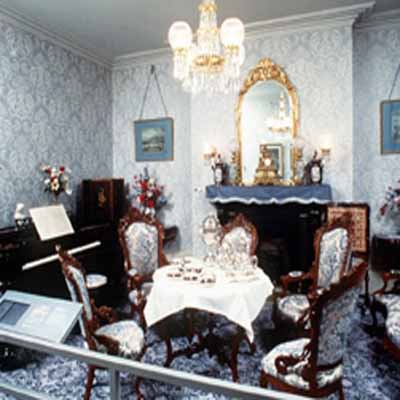Sir George-Étienne Cartier National Historic Site of Canada
Montréal, Quebec

Interior view
© Parks Canada Agency/Agence Parcs Canada, 1989.
Address :
458 Notre-Dame Street East, Montréal, Quebec
Recognition Statute:
Historic Sites and Monuments Act (R.S.C., 1985, c. H-4)
Designation Date:
1964-10-27
Dates:
-
1836 to 1838
(Construction)
-
1848 to 1873
(Significant)
Event, Person, Organization:
-
Sir George-Étienne Cartier
(Person)
Other Name(s):
-
Sir George-Étienne Cartier
(Designation Name)
-
Cartier House
(Plaque name)
Research Report Number:
1962-021, 1964-030, 2003-013, 2003-021, 2002-SDC/CDE-031
DFRP Number:
07137 00
Plaque(s)
Existing plaque: 458 Notre-Dame Street East, Montréal, Quebec
These two semi-detached houses were constructed about 1837, and each served as the home of one of Canada’s most distinguished statesmen, Sir George-Étienne Cartier (1814–1873), who occupied the east house from 1848 until 1855, and the west house from 1862 to 1872. Cartier shared the leadership of the Province of Canada with Sir John A. Macdonald for most of the decade after 1857, and was one of the principal architects of Confederation (1867). He became a leading member of the first Dominion cabinet, in which he served as Minister of Militia and Defence.
Original Plaque:
Typical of the 19th century architecture of Old Montreal, this building was constructed about 1837 as a double residence and twice served as the home of one of Canada's distinguished statesman, George-Etienne Cartier ( 1814-1873), who occupied the east half of this building from 1848 until 1854 and the west half between 1862 and 1872. Cartier shared with John A. Macdonald, the leadership of the Province of Canada for most of the decade after 1857 and was one of the principal architects of Confederation. He became a leading member of the first Dominion cabinet Which he served as Minister of Militia and Defence.
Description of Historic Place
Located at the corner of Notre Dame and Berri streets, in downtown Montreal, this masonry building occupies a little more than half of its urban lot. The two semi-detached houses occupying this lot had been part of a three house urban terrace on what had been the site of the Montreal citadel . One part of the house presents the life and work of Father of Confederation George-Étienne Cartier, upper-middle class Montrealer, politician and Father of Confederation, and the other has been restored to present the domestic setting of the Cartier family during the 1860s.
Heritage Value
Sir George-Étienne Cartier National Historic Site of Canada was commemorated because: these two houses together served as the residence of a major Canadian political figure,
Sir George-Étienne Cartier, Cartier was the Prime Minister of the Province of Canada between 1858 and 1862; Cartier was one of the principal Fathers of Confederation Cartier was one of the most influential members of the first Canadian cabinet.
The heritage value of Sir George-Étienne Cartier National Historic Site of Canada resides in its association with George-Étienne Cartier, whose political career lasted from 1848 to 1873, and in its illustration of an upper-middle class Montreal home in the middle of the 19th century, showing both French and English architectural influences.
Sources: Historic Sites and Monuments Board of Canada, Minutes, June 2001; Commemorative Integrity Statement, 2004.
Character-Defining Elements
Key features contributing to the heritage value of this site include: evidence of the amalgamation of two neighbouring houses into one building under a falsemansard roof in the Second Empire style; the “east” house as it survived, amputated by some three metres in 1893; the covered passage serving the two neighbouring houses; the cut-stone facade and the rubble-stone rear elevation; the fire walls; the plan of the “west” house, including basement, ground floor and first floor; the vaulted side entry of the “west” house; the surviving original interior decoration with its architectural woodwork and its distinction between private and public rooms; the house as a rare surviving example of the fine workmanship and generous size of mid-19th-century houses around the former Dalhousie square, houses mostly destroyed by fire in 1852.